HTHSCI 2LA2A - Week #1: Stress & Adaption
1/78
There's no tags or description
Looks like no tags are added yet.
Name | Mastery | Learn | Test | Matching | Spaced |
|---|
No study sessions yet.
79 Terms
Stress
- A state manifested by a specific syndrome of the body, developed in response to any stimuli that made an intense systematic demand on it"
- "A person experiences stress when a demand exceeds a person's coping abilities, resulting in reactions such as disturbances of cognition, emotion, and behavior that can adversely affect well-being"
- "Stress is the spice of life" (could be beneficial but also could cause disease, suffering, or death).
- One person's stress could be another person's lifestyle, stress is different for everyone.
Stress Components
- The stressors.
- The stress response.
- The Pathophysiological sequelae.
About Stress
- It is a response.
- Stressors are everywhere, but they do not necessarily lead to stress.
- Sources: Includes external stimulus, individual judgement and a physiological response.
- This non specific response, where it is short-term or a chronic stimuli, causes similar hormonal responses.
Adrenal Gland Layers
- Outermost = Capsule (tough fibrous capsule enclosed in fat for protection).
- Cortex (forms the bulk of the gland- 80-90%; made up of 3 parts: Outermost = Zona glomerulosa, Zone fasciculata, Zone reticularis).
- Adrenal Medulla: Part of the sympathetic nervous system and is made out of nerves; makes up 10-20% of the gland).
Retroperitoneal glands
Adrenal Glands Diagram

Physiological Response: HPA Axis (Hypothalamic Pituitary Adrenal Axis)
*Sensory input (stressor) can be external (ex. pain) or internal (ex. fear).
Whatever the sensory input, the response is the same
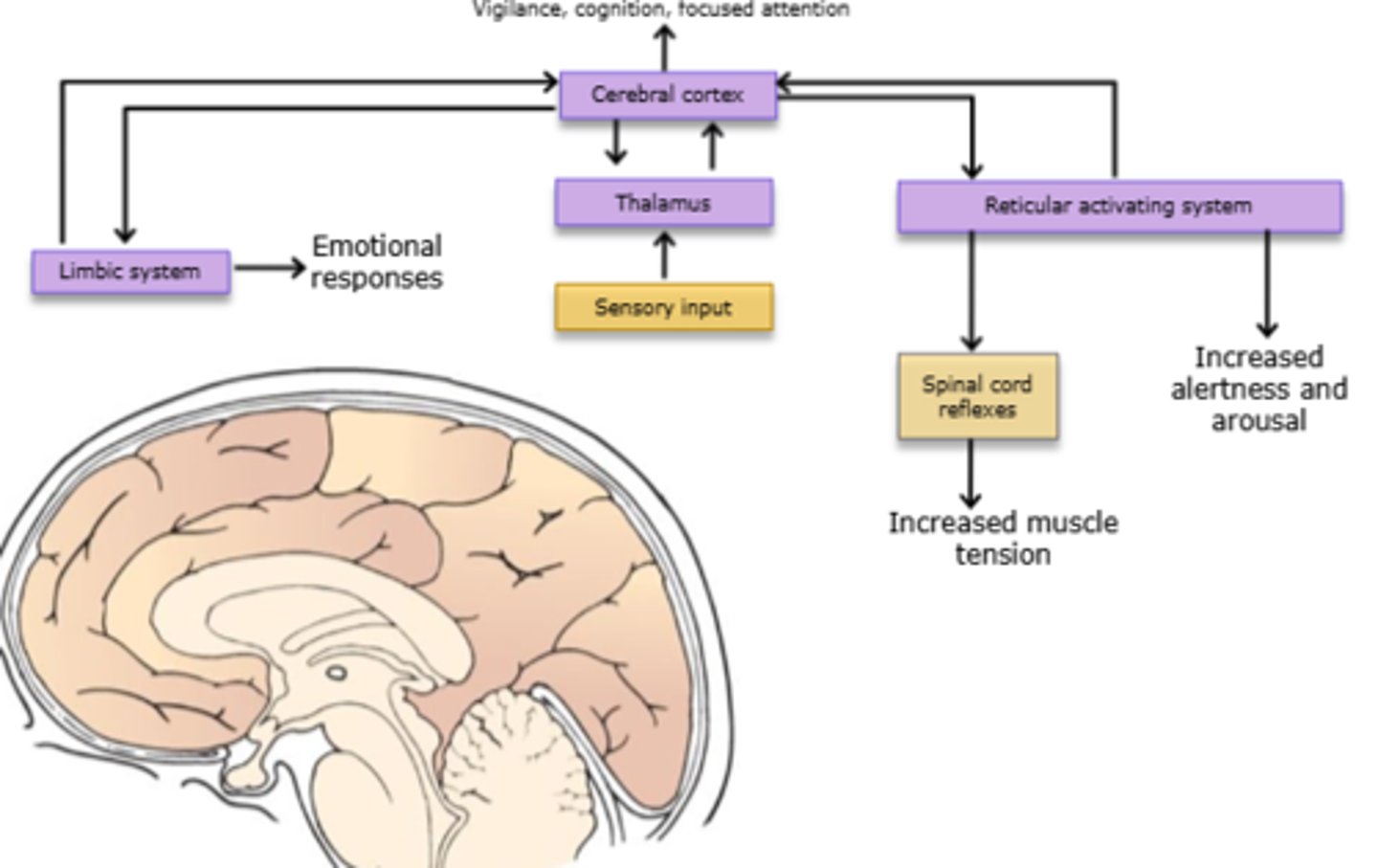
Physiological Response: HPA Axis - Hypothalamus Diagram
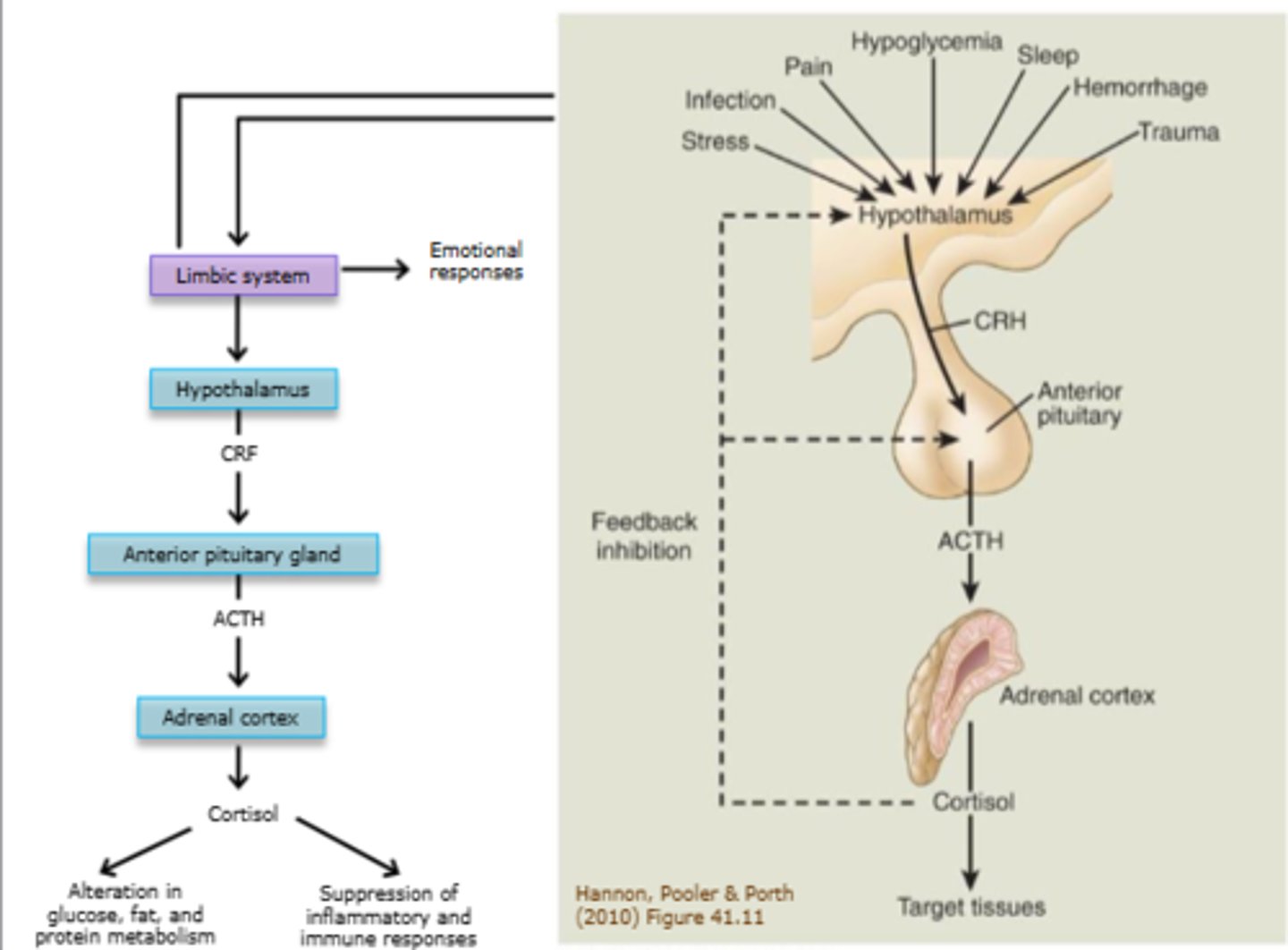
Hypothalamus
- Clearing house for many homeostasis controls.
- Both an autonomic and endocrine control center.
- Hypothalamus releases cortical tropine releasing hormone or factor (CRH or CRF).
- CRH or CRF stimulates the sympathetic nervous system by the locus ceruleus, the anterior pituitary, and posterior pituitary.
- CRF or CRH causes the anterior pituitary gland to release ACTH (adrenal corticotropic hormone).
- ACTH is responsible for secreting hormones out of the adrenal glands, specifically from the adrenal cortex (zona fasciculata).
- Cortisol is mostly bound to something (ex. albumin) so it is not absorbed by the liver, however it needs to become un-bound when it requires to be physiologically active.
Cortisol Roles
- Alteration in glucose, fat, and protein metabolism.
- Suppression of inflammatory and immune responses.
Locus Ceruleus
- Activating center for the autonomic nervous system.
- Norepinephrine is synthesized here (once synthesized in travels b the afferent pathways back to the hypothalamus, limbic system, hypocampilaria, and cerebral cortex).
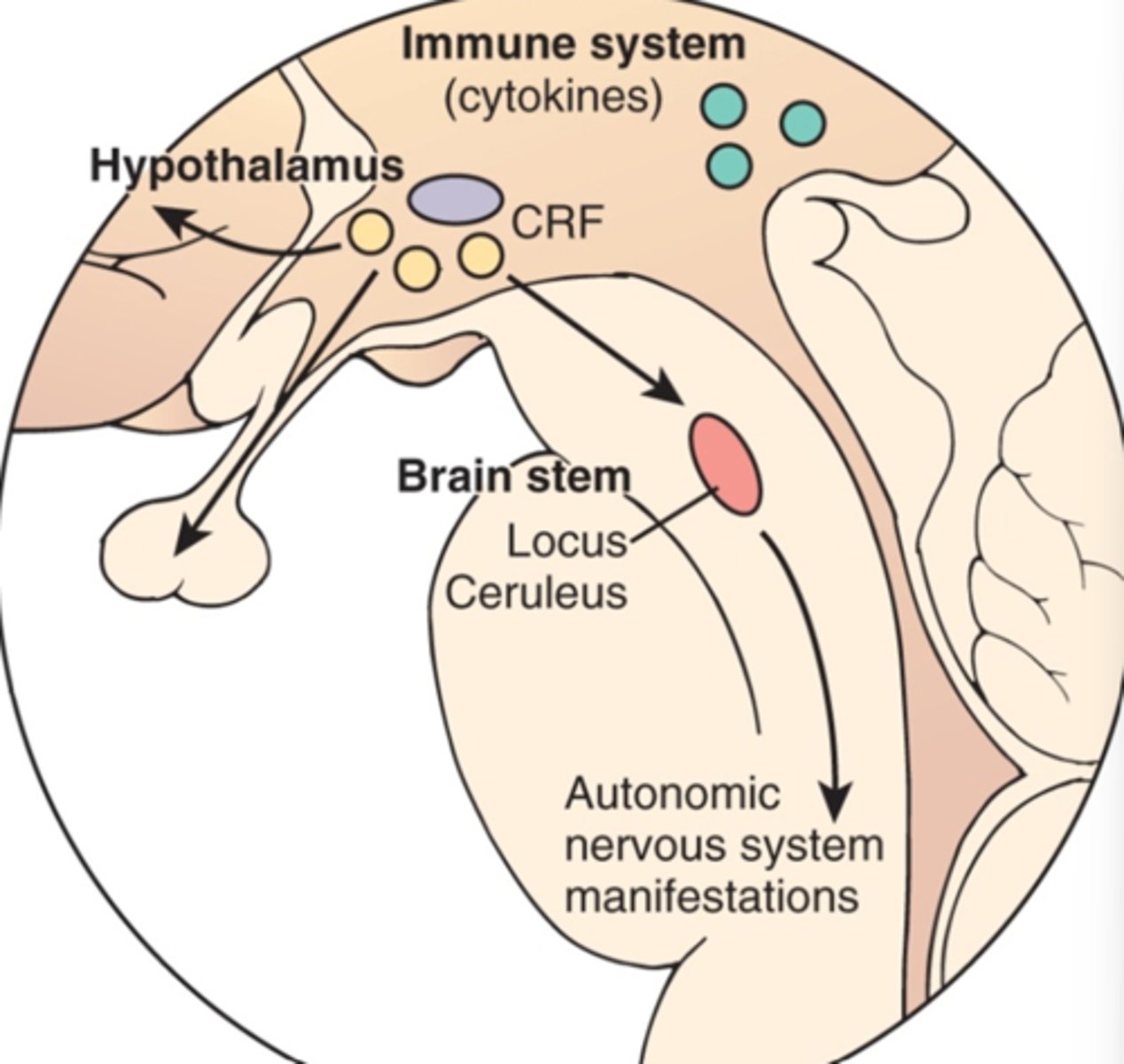
Sympathetic vs. Parasympathetic Nervous System
- Sympathetic will dominate over the parasympathetic when a stimulus is present.
- Sympathetic releases epinephrine and norepinephrine to create the fight or flight response.
- Parasympathetic creates the opposite response and brings the body back to homeostasis.
Epinephrine
- Increase the glucose in the body through gluconeogenesis, glycogenolysis; limits the up-take of peripheral glucose and pancreases production of insulin.
- Causes bronchodilation.
- Increase contractility.
- Increase HR, impacting cardiac output.
- Signal from medulla to be released at the adrenal glands.
Norepinephrine
- Impacts arousal.
- Increases vigilance and anxiety.
- Increase sweat gland (palms and armpits).
- Triggers piloerection (goose bumps).
- Increases cardiovascular arterial smooth muscle constriction (increasing blood pressure).
- Signal from medulla to be released at the adrenal glands.
Hormones Altered by the Stress Response
- Cortisol.
- Beta-endorphins (increased causes reduced pain sensations).
- Prolactin (released during stress).
- Growth hormone (increased demands of GH affects protein, lipid and carbohydrate metabolism; counters the effects of insulin).
Physiological Response Diagram
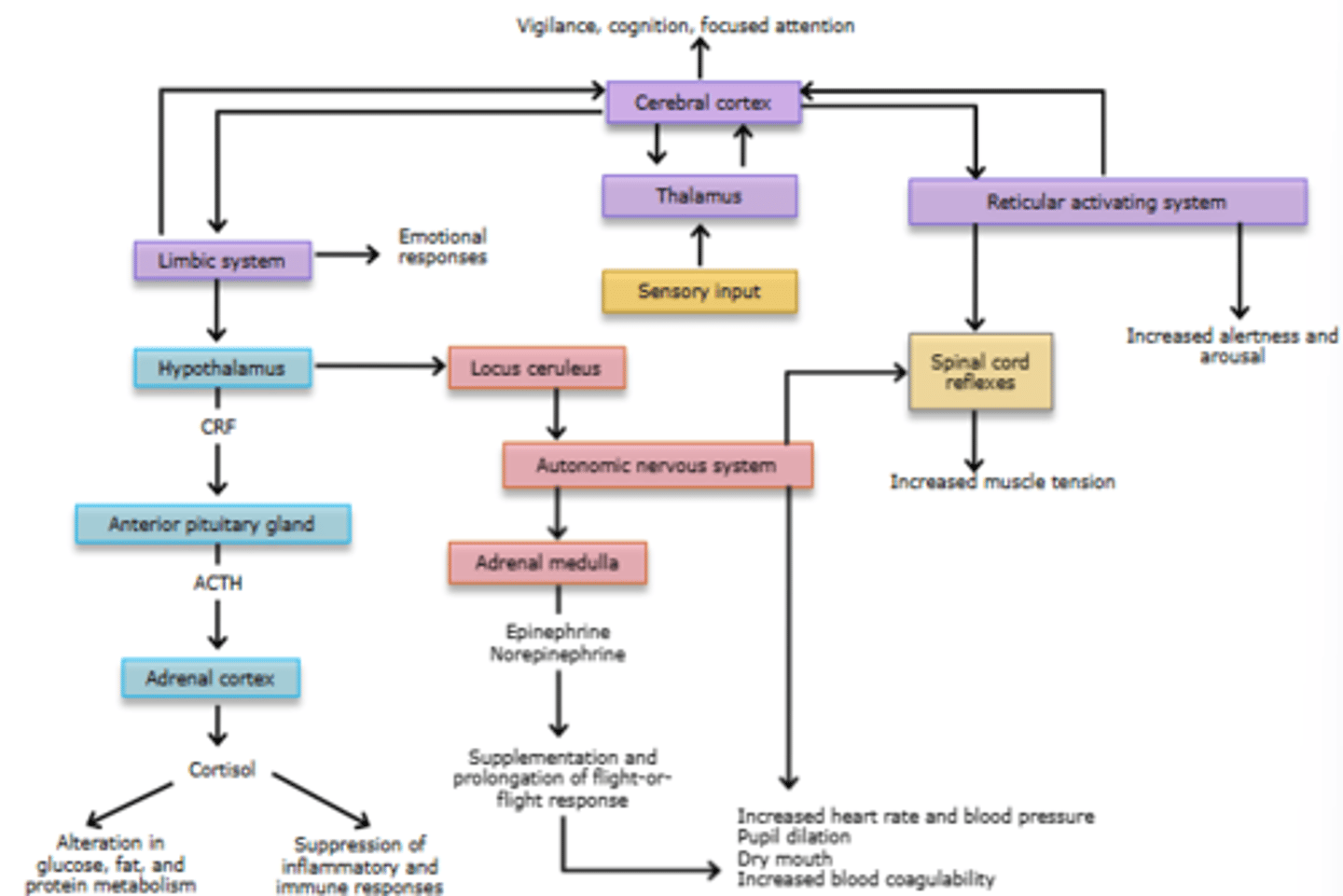
Posterior Pituitary Gland
- Releases ADH (vasopressin) once trigged in a stress response which causes the retention of water and sodium.
- ADH works together with the autonomic nervous system and cortisol during extremely stressful times due tot he high levels of CRF and ACTH in the body.
HPA Axis Overview
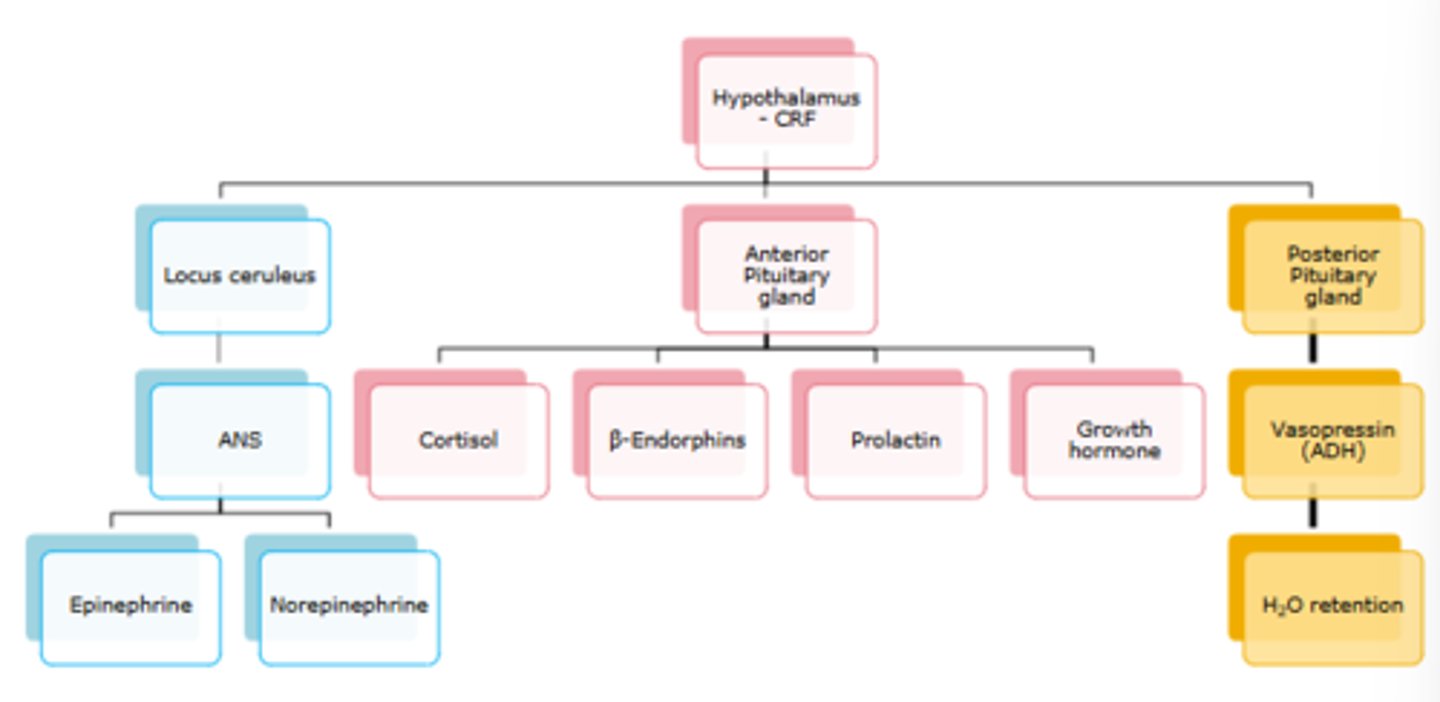
Acute Stress Feedback
- Occurs at the hypothalamus and the anterior pituitary gland.
- Normally their is an activation of a negative feedback system that decreases synthesis and release of more cortisol.
- Increased level of cortisol inhibits the hypothalamus from releasing more CRF and the anterior pituitary from releasing ACTH.
- This allows the body to deal with the situation as an acute self-limited response.
Chronic Stress Feedback
- Negative feedback system becomes desensitized and is no longer responsive to increased levels of cortisol.
- This enables the hypothalamus to secrete more CRF and the anterior pituitary gland to secrete more ACTH.
- Causes neural and hormonal connections to become dysfunctional with prolonged activation.
Short Term vs. Long Term Stress
Short:
- More catecholamines being released then corticoids.
- Will feel more effects from the high levels of epinephrine and norepinephrine being released.
Long:
- More corticoids being released the catecholamines.
- Related to high glucose, hypertension, retention.
Short Term vs. Long Term Stress Diagram
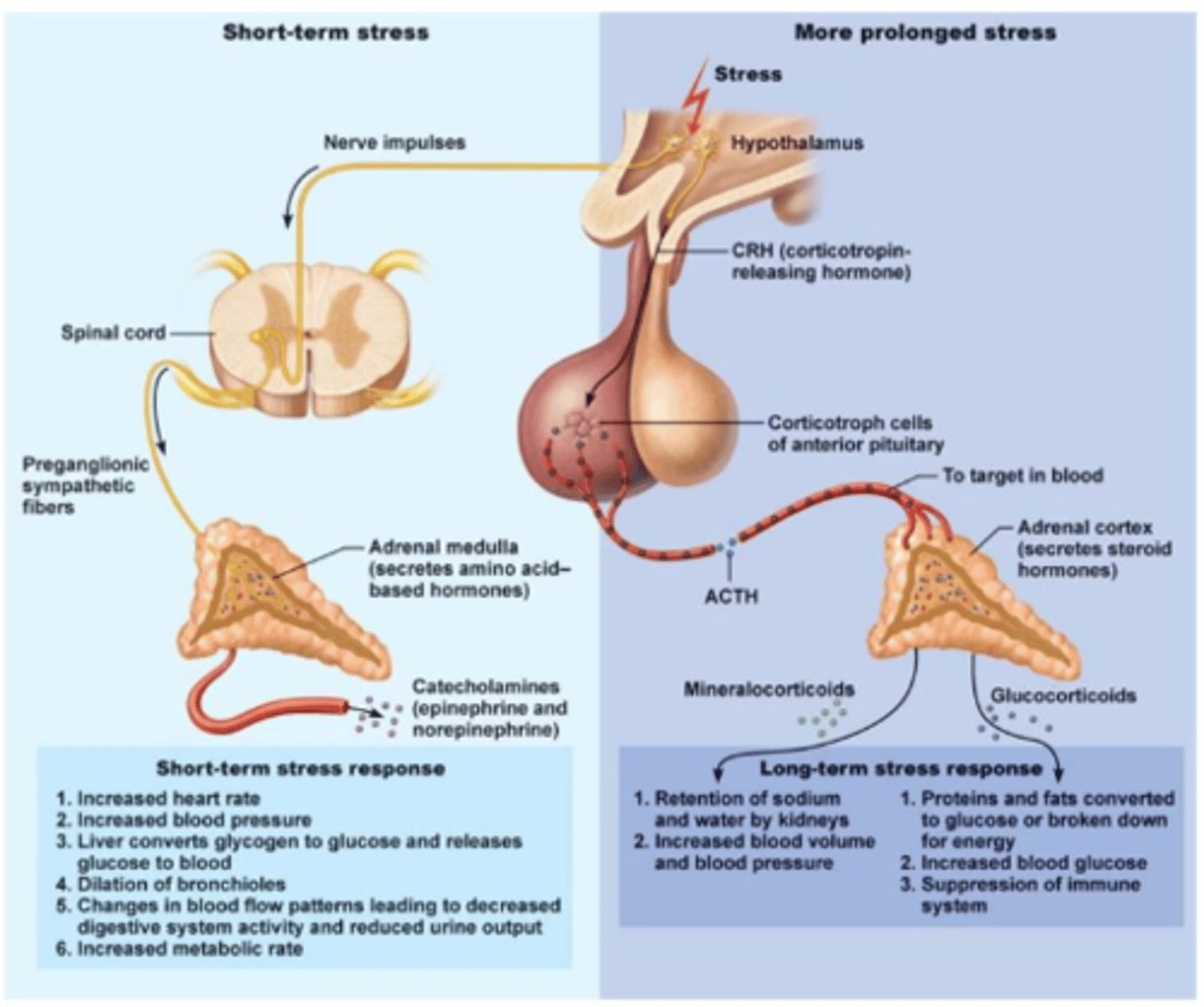
Positive Consequences of the Stress Response
- Hypermetabolic state (lipolysis, gluconeogenesis, glycogenolysis; causes increased nutrients to support healing and energy).
Negative Consequences of the Stress Response
- Loss of muscle mass due to gluconeogenesis.
- Nitrogen depletion due to removal in the urine.
- Immune system suppression due to a decreased number of T cells.
- Hyperglycemia.
- Cardiovascular wear and tear (due to constant catecholamine release).
Possible Measurements for the Stress Response
Biological:
- Testing the blood for hyperglycemia.
- Test the adrenal function (measuring ACTH, aldosterone, cortisol).
- Test cardiovascular activity with blood pressure and pulse.
- Test urinary nitrogen (see how much protein breakdown is occurring).
Psychological/Psychosocial:
- Assess anxiety, fear, mood, coping, support, etc.
- Includes self-reporting.
Trier Social Stress Test (TSST)
- Purpose was to induce large and consistent endocrine and cardiovascular stress responses, and moderate to high subjective stress.
- Looked at public speaking response to stress over 5 days (in 20 males).
- Inserted IV 30 minutes before test began.
- Were in front of 3 "managers" and they needed to convince them who they were and why they were perfect for the job.
- Given 10 minutes to prepare for their talk.
- Had to give a 5 minutes speech and answer prepared questions.
- Then asked to subtract 13 from 1022 as fast and accurately as possible.
- Researchers collected cortisol, GH, ACTH, and prolactin samples.
Results:
- Even 30 minutes after the test was completed, the cortisol levels were at their peak and well above their base line over an hour later.
- After 5 das they showed less cortisol in their response and were closer together in results.
Trier Social Stress Test (TSST) Diagram
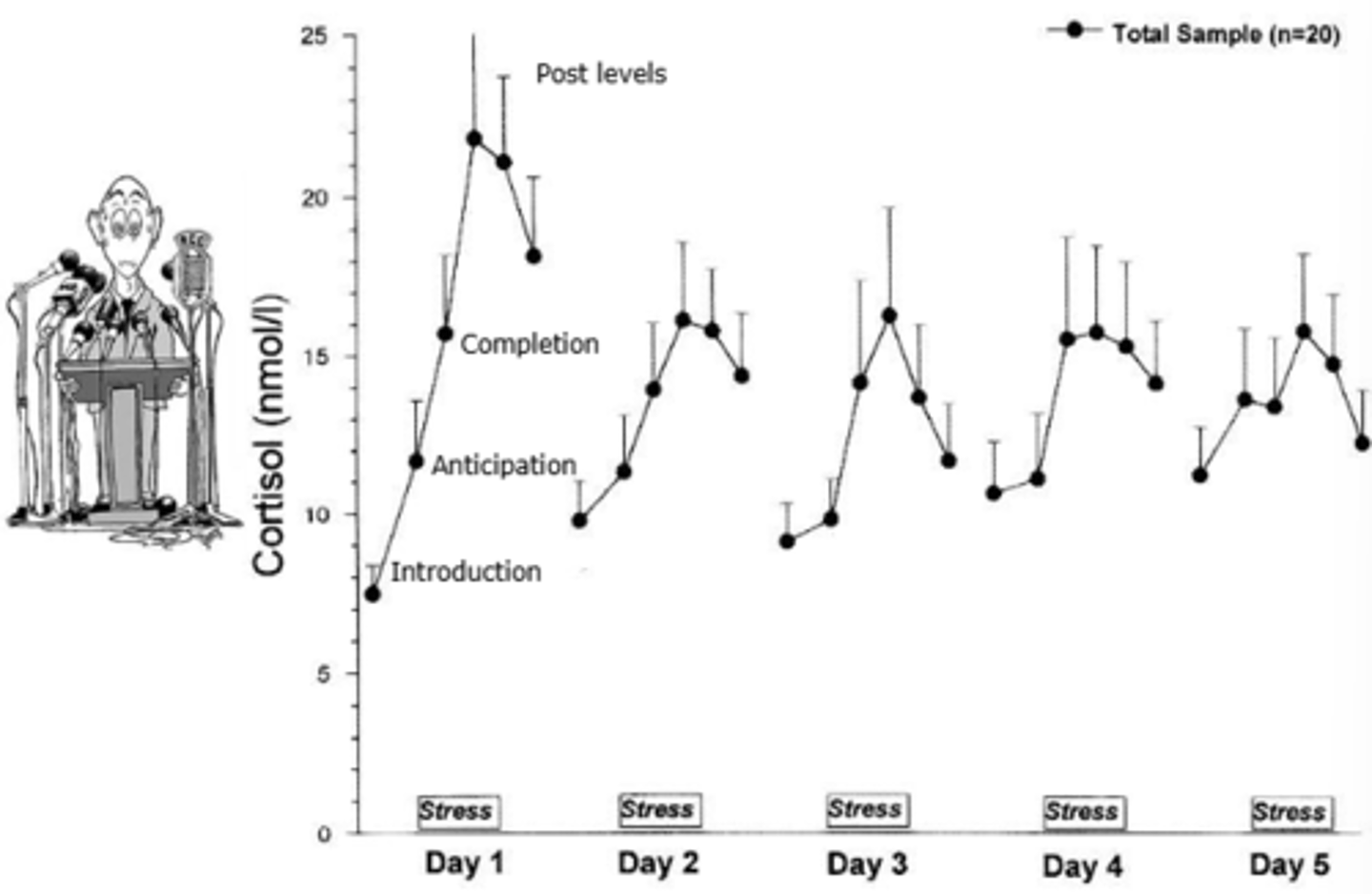
Stress & Healing
- Decreased immune response to vaccines.
- Increased susceptibility to infections (due to decreased T cells and increased cortisol levels; adaptive immune response is suppressed).
- Slow wound healing (due to large amounts of inflammation from stress response).
Slow Wound Healing Study
- Caregivers (for dementia): 24% longer for wound to heal.
- Students (academic stress): 40% longer for wound to heal.
- Couples (with hostile behaviors): 60% longer for wound to heal.
Stress & the Brain
High levels of cortisol impairs hippocampal function:
- Neuronal atrophy and destruction (atrophy of dendrites which can cause short-term memory difficulties; usually reversible if stress is short-term).
- Decreased short term memory.
- Decreased accuracy of contextual memories and impaired reliability.
- Impaired ability to recognize threat and situation.
Hippocampus
- Important for verbal and memory responses.
- Sensitive to glucocorticoids (ex. cortisol).
- Sustained stress levels can damage hippocampus.
Clinical Implication of Stress
- insomnia.
- Back, shoulder, and neck pain/aches.
- Muscle tension.
- Clenched jaw.
- Headache.
- GI Symptoms: Upset stomach, reflux, gas, irritable bowel, heart burn, ulcer, constipation, diarrhea, weight gain, weight loss, eating disorders.
- Hypertension.
- Arrythmia's.
- Palpations.
- Chest pain.
- Asthma.
- Shortness of breath.
- Skin problems (hives, eczema, psoriasis, ticks, itching, acne).
- Poor wound healing.
- Reproductive problems (dropping sexual interest, decreased estrogen or testosterone levels).
- Tachycardia.
- Sweating hands and feet.
-
Nervous System - Stress Related Diseases
- Neuropsychological manifestations.
- Fatigue.
- Anxiety.
- Loss of motivation.
- Depression.
- Insomnia.
- Overeating.
- Addiction.
Cardiovascular System - Stress Related Diseases
- Heart rate.
- Arrhythmias.
- Hypertension.
- Heart failure.
- Stroke.
- Coronary artery disease.
Gastrointestinal System - Stress Related Diseases
- Crohn's disease.
- Heartburn/GERD.
- Gastritis.
- Ulcer.
- Malabsorption.
Musculoskeletal System - Stress Related Diseases
- Tension headache.
- Backache.
- Inflammatory disease of connective tissue.
- Arthritis.
- Muscle wasting.
- Osteoporosis.
Integumentary System - Stress Related Diseases
- Eczema.
- Psoriasis.
- Dermatitis.
- Acne.
- Alopecia.
- Poor wound healing.
Endocrine System - Stress Related Diseases
- Hyperglycemia.
- Diabetes mellitus.
- Amenorrhea.
- Cushing disease.
- Addison disease.
Respiratory System - Stress Related Diseases
- Respiratory rate.
- Hypersensitivity reactions (i.e. asthma).
- Exacerbations of COPD.
Immune System - Stress Related Diseases
- Immunodeficiency.
- Immunosuppression.
- Autoimmune diseases.
Genitourinary System - Stress Related Diseases
- Diuresis.
- Irritable bladder.
- Renal failure.
- Impotence.
- Menstrual irregularities
Emotional Symptoms of Stress
- Nervousness, anxiety.
- Phobias.
- Depression, moodiness.
- Butterflies.
- Irritability, frustration.
- Overreactions.
- Memory problems.
- Feeling out of control.
- Substance abuse.
Implications:
- Impact of health teaching.
Clinical Interventions for Stress
1. Eliminate stressor (s).
2. Management of stress response/stressor's (positive coping mechanisms such as journaling vs. negative coping mechanisms such as drug or alcohol use) (attempt to prevent or reduce the stress response by encouraging coping and decreasing environmental impacts).
3. Blocking the stress response (distancing oneself, self-control, accepting responsibility, reform the appraisal).
Non-Pharmalogical Treatments for Stress
- Relaxation (ex. controlled breathing exercises).
- Imagery.
- Exercise (decreases effects of stressors on the bod).
- Music or massage therapy.
- Biofeedback.
Factors Affecting Adaptation

Sport's Fans & Stress
- Sport's fans of a team in Germany has a high rate of cardiac events that led to mortality during one game where they won and another were they lost.
- It was determined that as well with other games, the stress that the games brought to the fans led to these events and that their were many more cardiac related events in hospitals during the time/day of the game.
Women & Effects of Chronic Stress
- Had a lesser chance of getting breast cancer compared to the normal population.
Impact of Coping
- Women with breast cancer have a better chance of survival if the are involved in support groups.
- When patient's has regular pain relieving methods post-op the were less likely to get masticates.
- Individuals who cared for people with dementia are 6 times more likely (especially in men) to develop dementia themselves.
Problems with Stress Related Research
- Hard to create research due to an individuals own perception of their stress response.
- Interpretation and degree of stress is different for everyone.
Stress & Nursing
- Assessing patients stress levels and coping strategies are among the most important nursing interventions you can implement.
Case Scenario:
Sandra, a 26 year old newly widowed mother of 2 (Jimmy, born 2 weeks ago via C-section and Susie, age 4).
Sandra is thinking about looking for a babysitter to help her at home but isn't sure she can afford this.
her mother-in-law will only help with the children for a couple hours on the weekends, but even then Sandra admits she's not always reliable.
Bloodwork:
- Hyperglycemia.
- Hypernatremia.
- Hypokalemia.
Neurological:
- Cognitive symptoms (short term memory loss).
- Emotional symptoms (agitation).
- Physical symptoms (headache).
- Behavioral symptoms (isolation self).
Cardiovascular:
- Increased HR.
- Increased BP.
- Palpitations.
Abdominal:
- Heartburn.
- Weight loss or gain.
- Poor wound healing.
Adrenal Insufficiency
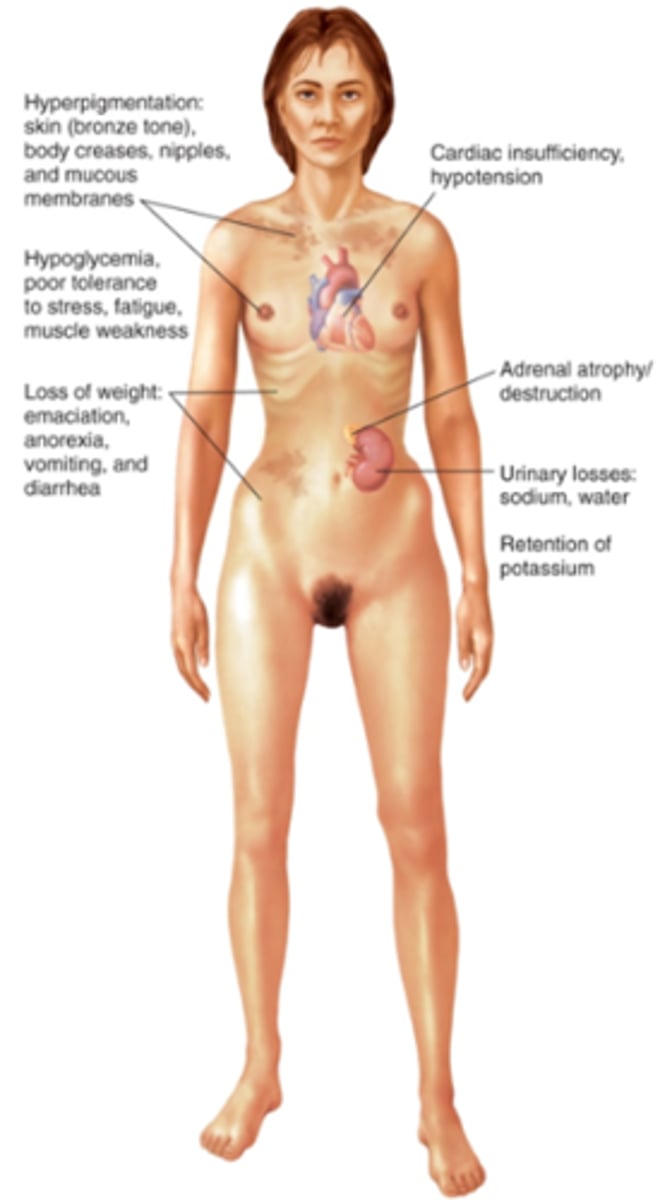
Cushing Syndrome

Adrenal Gland Hormones: Summary of Regulation & Effect
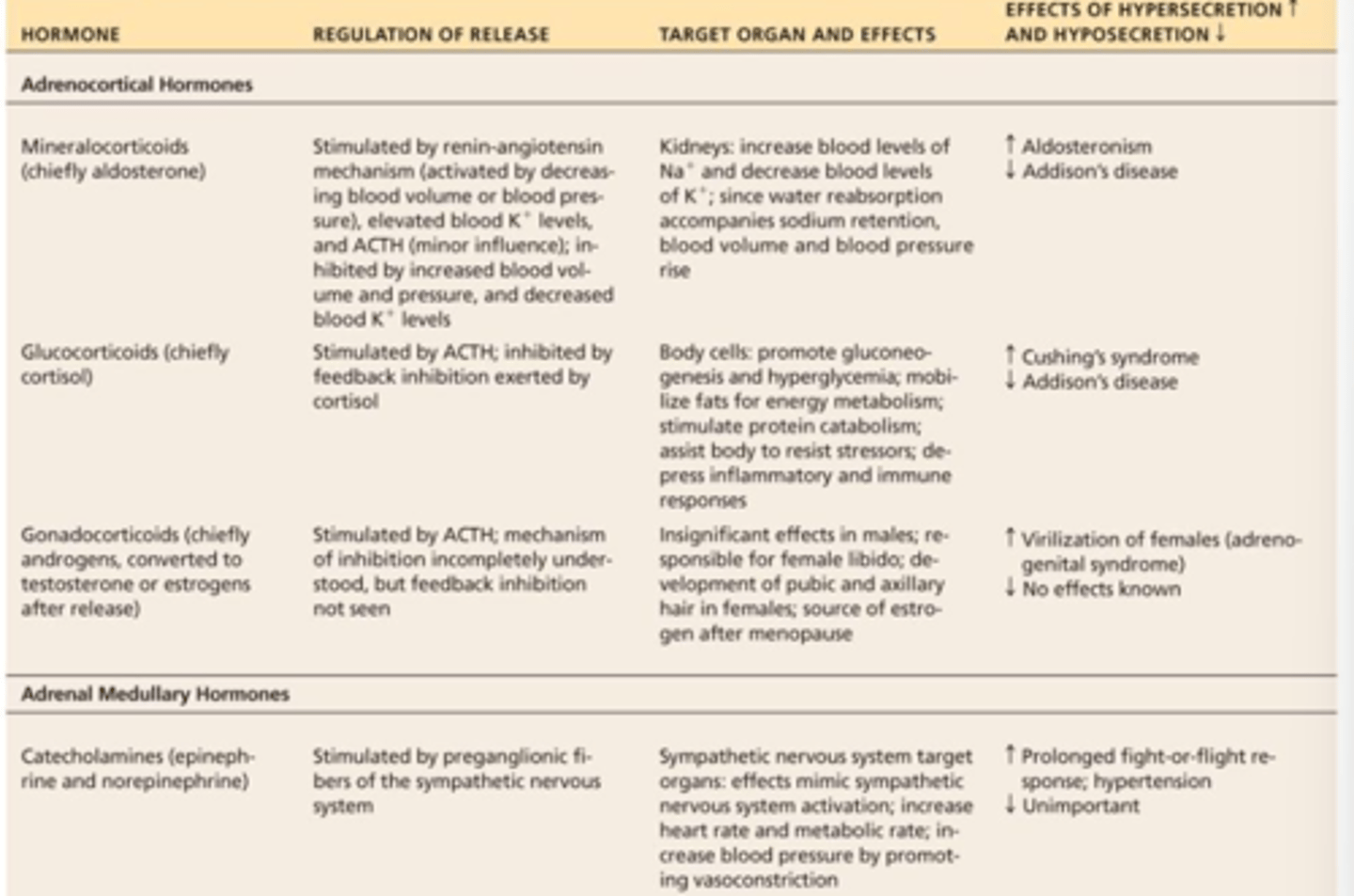
Review from Level 1
Medulla
- The most caudal part of the hindbrain, located directly above the spinal cord.
- The medulla is vital for functions such as breathing, digestion, and regulation of heart rate.
- Regulates autonomic reflexes (ex. sneezing, swallowing, vomiting).
Cerebellum
- Translating to "little brain", it is a structure in the hindbrain resembling miniature version of the entire brain.
- Coordinates motor movement and so damage to this area can result in exaggerated, jerky movements.
Hypothalamus Review
- Part of the limbic system in the forebrain, which regulates the flight, flight, feeding, and reproduction.
- Directs stress response.
- Regulates energy metabolism (influences feeding, digestion, and metabolic rate).
- Hormonal control (mating, pregnancy, lactation).
- Urinary control, thirst, hunger, shivering.
- Collection of nuclei.
- Endocrine regulation.
Amygdala
- Located below the surface of the temporal lobe that plays a role in decoding emotions (particularly fear).
- Receives sensor stimulation.
- if damaged, their is often a deficit in the fear response (ex. PTSD).
Hippocampus
- In the temporal lobe.
- It is involved in memory formation and the ability to navigate through the world.
- Maintains a spatial map.
- Storage of short-term memory.
- Transfer to long-term memories.
- Connected to the amygdala.
- Where neurogenesis (creation of neurons) occurs in adulthood.
- Works to encode and consolidate episodic and semantic memory for long-term storage across the cortical regions.
Thalamus
- Part of the forebrain that acts as a "relay station" from the cerebellum, limbic system, and every sensory area (except olfaction) to the cerebral cortex).
- Axons from ever modality synapse in the thalamus.
- Processes and regulates info to the selective regions of the cerebral cortex.
Oxytocin
- Involved in basic physiological function.
- Lactation and uterine contractions.
- Roles in bonding, love, and trust.
Vasopressin
- Vital blood hormone.
- Regulates levels of thirst b interacting with the kidneys to regulate glucose levels.
- Regulates water, glucose, and salt in the blood.
Pituitary
- Referred to as the mast gland of the endocrine system, it has 2 sub-regions.
- The anterior pituitary receives signals from the brain to releases hormones that regulates other endocrine glands such as the thyroid, testes, and ovaries.
- The posterior pituitary is an extension of the hypothalamus and it releases the hormones oxytocin and vasopressin.
Neurogenesis
- The process by which neurons are created in the nervous system.
Autonomic Nervous System
- Part of the PNS.
- Controls muscle movement that happens outside of our conscious awareness and control.
- Most visceral organs have both types of visceral motor input and the effect on the organs is predictable.
- Can usually guess what the response of an organ will be with a given autonomic input if you think about it (ex. pupils).
- Sympathetic Input: Speeds up heart rate (appropriate fight or flight response).
- Parasympathetic Input: Slows heart rate (appropriate for rest and relaxation response).
- No voluntary input = No conscious control.
- Controls negative feedback loop and helps to maintain homeostasis (ex. blood pressure, breathing rate, digestion).
- Centers in the hypothalamus and brainstem to regulate ANS reflexes.
Organs receive input from both the sympathetic and parasympathetic nervous systems except:
- Visceral/peripheral arterioles have almost only sympathetic input.
- Eccrine sweat glands only have sympathetic input.
- Radial muscle of iris has sympathetic input (dilates the pupil).
- Iris sphincter muscle has only parasympathetic input (constricts the pupil).
Parasympathetic Nervous System
- Composed of the nervous system outside of the brain and spinal cord.
- Part of the autonomic nervous system.
- Helps to return the body to normal function after the activation of the sympathetic nervous system.
- Craniosacral division.
- Outputs are in some spinal nerves and brain.
- Responsible for orchestrating the 3 R's (rest, relax, ruminate) and SLUDD (salivation, lacrimation, urination, digestion, defecation).
Central Nervous System
- Composed of the brain and spinal cord.
Somatic Nervous System
- Part of the PNS
- It controls voluntary movements through skeletal muscles and transmits sensory information to the central nervous system.
- Involved with preparing the body for emergencies (fight or flight response).
Sympathetic Nervous System
- Uses norepinephrine.
- Sympathetic division: Thoracolumbar division.
- Responsible for 3 F's (fright, flight, fight).
- Sends out broadcasting message to the rest of the body (quick).
-
SNS - Adrenal Glands
- SNS talks with the adrenal glands.
- Adrenal medulla (middle): Hosts a collection of modified postganglionic neurons called chromaffin cells. Cells secrete epinephrine (adrenalin) and norepinephrine (noradrenalin) into the blood stream.
- Catecholamines: Stimulate all sympathetic effects through the same receptors activated by sympathetic axons.
- Endocrine hormones in blood amplify signals in nerves at the same time. Sends message out (causes release of epinephrine and norepinephrine in blood and the rest of the body).
ANS Anatomical Components
Sympathetic:
- Short preganglionic neuron.
- Acetylcholine (ACh) used at the ganglia. Receptors are Nicotinic.
- Norepinephrine (adrenaline) used in effector. Receptors are Adrenergic.
Parasympathetic:
- Long preganglionic neuron.
- Acetylcholine (ACh) used at the ganglia. Receptors are Nicotinic.
- ACh used on effector. Receptors are muscarinic.
Autonomic System Regulation
- BP, HR, digestive motility, pupil size, RR (CO2 & O2), pleasure, fear, rage, temp regulation, appetite, thirst.
Posterior Pituitary
- Produces peptides.
- Oxytocin: Uterine contractions and lactation.
- Vasopressin (ADH): Water retention, vasoconstriction (anti-direct hormone).
ANS Adrenergic Neurons
- Release the neurotransmitters norepinephrine (can also be released by adrenal medulla).
- Most sympathetic postganglionic neurons are adrenergic.
- These neurotransmitters are broken or removed slowly compared to ACh.
- COMT & MAO help to degrade these neurotransmitters.
- Slow removal/breakdown means that SNS responses last longer than cholinergic responses.
Cholinergic Neurons
- Release the neurotransmitters ACh which is quickly degraded by acetylcholinesterase.
Includes:
- Sympathetic and parasympathetic preganglionic neurons.
- All parasympathetic postganglionic neurons.
- Sympathetic postganglionic neurons innervating eccrine sweat glands (postganglionic ACh, not epinephrine).
ANS Adrenergic Receptors
2 Types:
- Alpha receptors: Bind with epinephrine and norepinephrine.
- Beta receptors: Bind preferentially with epinephrine.
Motor Divisions: Somatic vs. Autonomic
- Somatic: Only 1 motor nerve between the CNS and effector (Innervates skeletal muscle only ACh) (uses only ACh).
- Autonomic: 2 neurons between the CNS and effector (innervates cardiac/smooth muscle and/or glands of internal organs; uses pre and post ganglionic neurons) (uses ACh or norepinephrine).
- Both use transmitters.
SNS Adrenal Glands
1. Preganglionic neuron by sympathetic chain ganglia.
2. Adrenal cortex.
3. Adrenal medulla.
4. Chromaffin cell.
5. Catecholamine release.
6. Sympathetic effector (ex. blood vessel).
Reticular Activating System
- The RAS is a set if connected nuclei in the brain of vertebrates that is responsible for regulating wakefulness and sleep-wake transitions.
- Functions as a filter that blocks out unnecessary noise that can interfere with the processing of messages during sleep or alertness.
- Both an ascending and descending component.